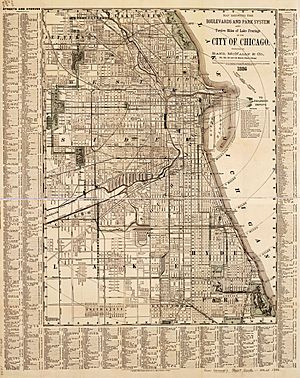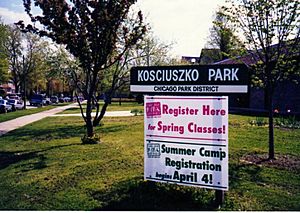Parks in Chicago facts for kids
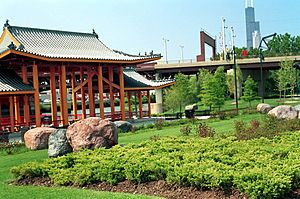
Chicago is known as the "City in a Garden," or Urbs in horto in Latin. This motto shows how important parks are to the city. Chicago has many parks, covering about 8.5% of its land. This makes it a city with lots of green spaces for everyone to enjoy.
These parks are not just for people living in Chicago. Many of them are also popular places for tourists to visit. Lincoln Park, for example, is Chicago's biggest park and one of the most visited parks in the whole United States. Over 20 million people visit it every year!
Many famous architects and artists have helped design Chicago's 570 parks. Some of these include Daniel Burnham, Frederick Law Olmsted, and Frank Gehry.
Contents
History of Chicago's Parks
The idea for Chicago's parks started a long time ago, even before the city was officially formed. In 1836, some smart citizens wanted the land along Lake Michigan to be a public space forever. They convinced city leaders to set aside two areas for public use.
One of these areas was named Lake Park in 1847. It was later renamed Grant Park in 1901. This park is still a very important part of downtown Chicago today.
As Chicago grew, more people wanted public parks. In 1842, Washington Square Park became one of the first smaller parks.
A big step for parks happened in 1860. A large part of the city's cemetery was turned into a park because people were worried about public health. This new park was first called Lake Park, but to avoid confusion, it was renamed Lincoln Park in 1865. This was done to honor President Abraham Lincoln, who had recently passed away. Over time, all the graves were moved, making Lincoln Park much larger.
In the 1850s and 1860s, cities like Paris and New York (with its Central Park) showed how important parks could be for city growth. William Butler Ogden, Chicago's first mayor, pushed for a plan to create a large park system on the South Side. In 1869, this plan was approved. The goal was to build a system of parks and wide streets (called boulevards) that would form a circle around Chicago.
Later, in 1891, J. Frank Foster had a new idea. He wanted to create smaller parks in working-class neighborhoods. These parks would have playing fields and special "field house" buildings. These field houses would offer lots of fun activities and services for people living nearby. These ideas for neighborhood parks became very popular and influenced park design across the country.
What You Can Find in Chicago Parks
The Chicago Park District takes care of 570 parks, covering over 7,600 acres of land. That's a lot of space!
This huge park system includes:
- Nine harbors along Lake Michigan, stretching over 24 miles.
- 31 beaches where you can swim and relax.
- 17 historic lagoons.
- 86 pools for swimming.
- 90 playgrounds for kids to have fun.
- 90 gardens to explore.
- 66 fitness centers.
- Nine ice skating rinks.
- 10 museums.
- A zoological park (Lincoln Park Zoo).
- Two plant conservatories (places with many different plants).
Chicago parks also have special places for activities like golfing, boating, boxing, and baseball. There are even parks just for dogs!
Beyond just maintaining the parks, the Chicago Park District hosts thousands of events every year. These include community gatherings, holiday celebrations, nature programs, sports events, music concerts, and art festivals. Many of these events happen in the summer when kids are out of school, making the parks lively and fun places to be.
Park Architecture
Many of Chicago's park buildings, especially the fieldhouses, are built in styles like Georgian or Classical Revival. These styles often feature grand, classic designs.
Some park buildings are very special and are considered important pieces of architecture. For example, Portage Park and Jefferson Park are listed on the National Register of Historic Places. This means they are recognized for their historical and architectural importance. Pulaski Park is also an official landmark of the City of Chicago.
Forest Preserves
Besides the city parks, Chicago also has Cook County Forest Preserves. These are separate natural areas with forests, prairies, wetlands, streams, and lakes. They are located around the edge of the city and offer even more green space for people to enjoy nature.
List of Parks
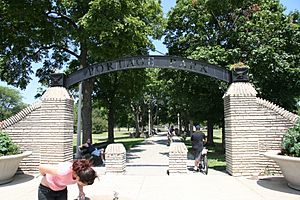
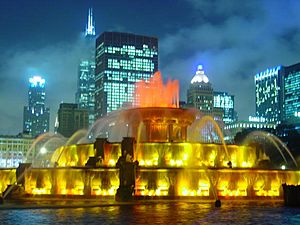
Notable Parks
- Burnham Park - 598 acres; runs along the lakefront on the South Side, connecting Jackson Park with Grant Park.
- Calumet Park - 200 acres; located on the lake, near the border with Indiana.
- Columbus Park - 144 acres; on the far west side of Chicago, it's considered one of the 150 Great Places in Illinois.
- Douglass (Anna and Frederick) Park - 173 acres; named after Frederick Douglass and his wife Anna Murray Douglass, located southwest of downtown.
- Garfield Park - 185 acres; this west side park has a beautiful conservatory and a lagoon.
- Grant Park - 319 acres; located in The Loop downtown. It's home to Buckingham Fountain and hosts major festivals like the Taste of Chicago and Lollapalooza.
- Humboldt Park - 207 acres; on the west side, it was once a cultural center for Chicago's Puerto Rican Community.
- Jackson Park - 500 acres; located on the south side of the city on Lake Michigan. This park was famous for its role in the 1893 World's Columbian Exposition.
- Lincoln Park - 1200 acres; Chicago's largest city park. Located north of The Loop, it stretches along Lake Michigan and Lake Shore Drive.
- Marquette Park - 300 acres; the largest park in southwest Chicago, it has a golf course and many other attractions.
- Millennium Park - 24.5 acres; Chicago's newest major park, opened in 2004, located just north of the Art Institute of Chicago within Grant Park.
- Washington Park - 372 acres; located on the south side, it was the proposed location for the stadium of the 2016 Summer Olympics.
Gallery
-
Buckingham Fountain, Grant Park
-
Flagstone steps in Portage Park
-
Jefferson Park with a view of the fieldhouse designed by Clarence Hatzfeld


